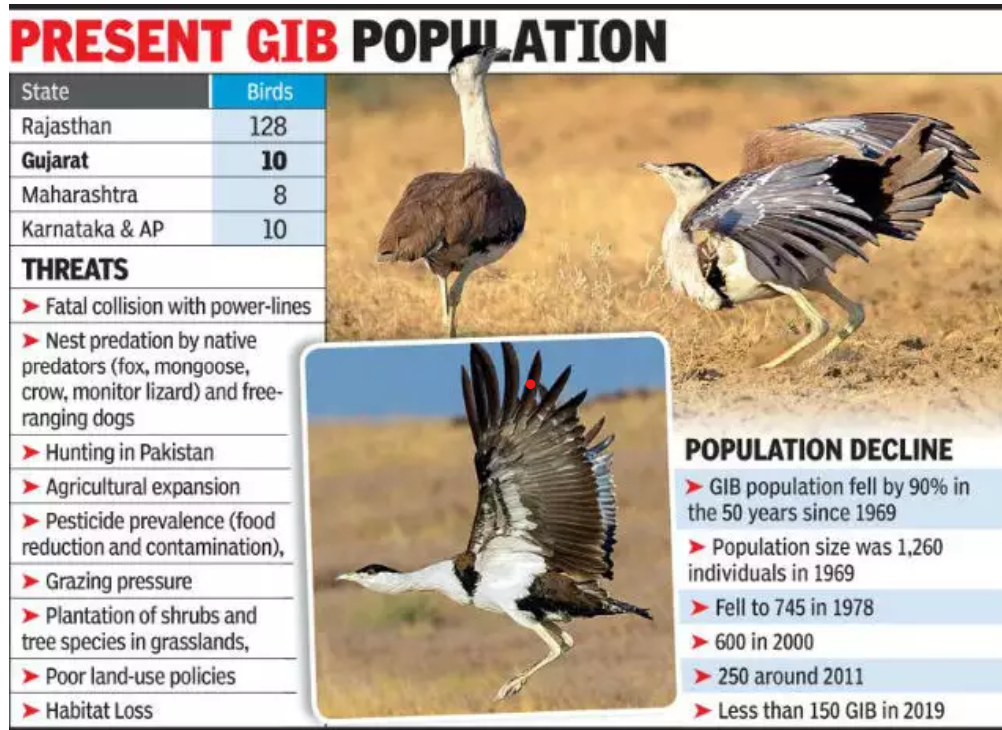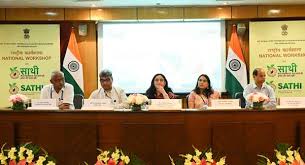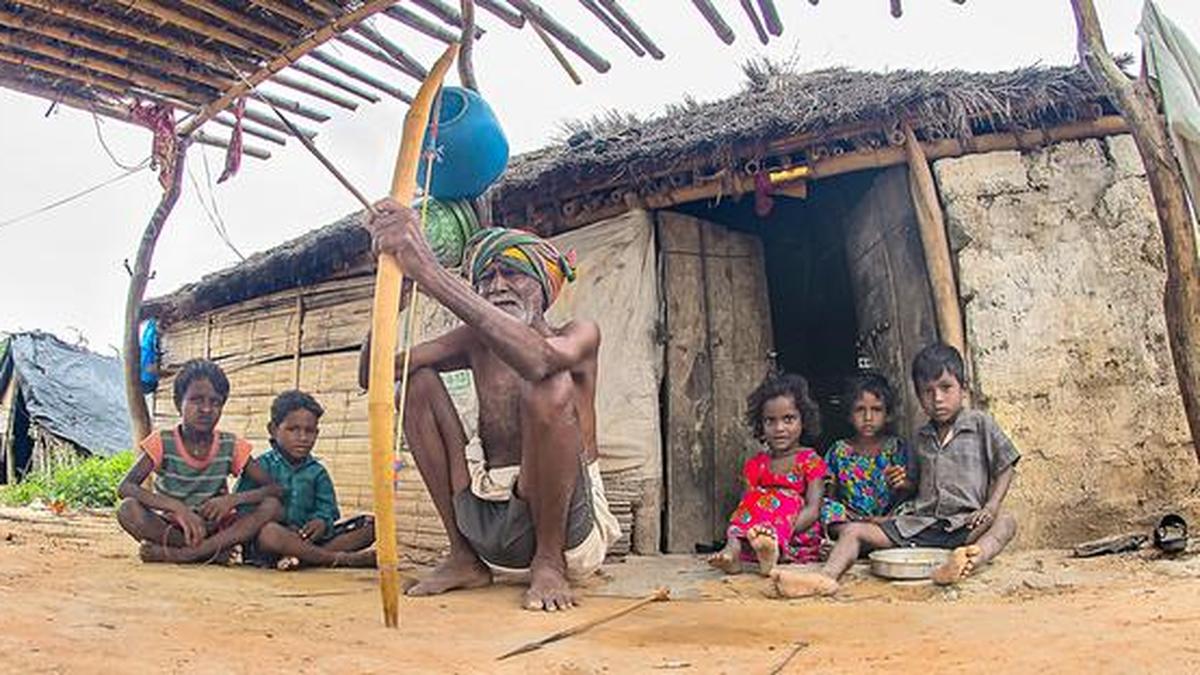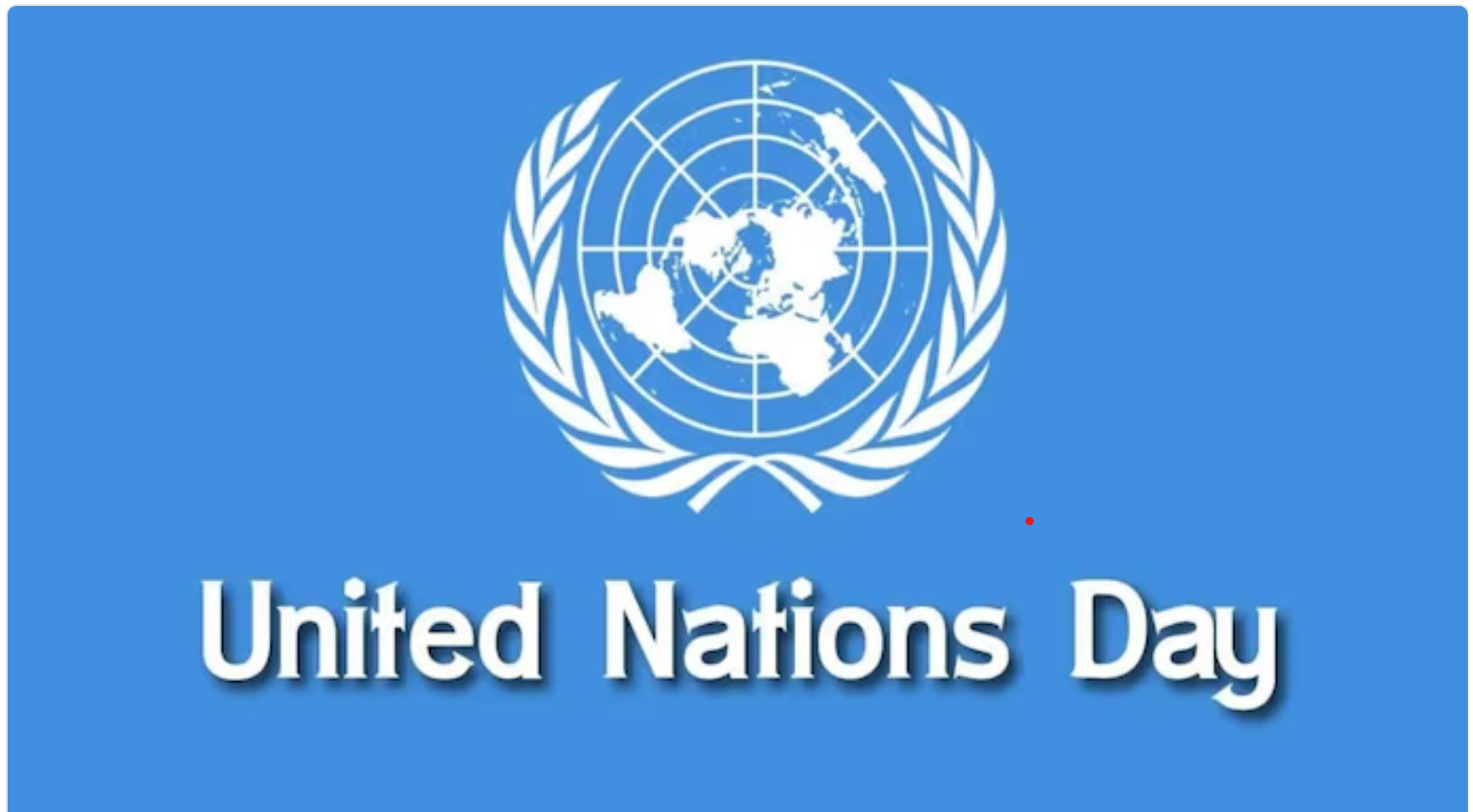Great Indian Bustard (GIB)

- 25 Oct 2024
A critically endangered Great Indian Bustard (GIB) chick was successfully born through artificial insemination (AI) at a breeding center in Jaisalmer, Rajasthan, marking a crucial step in efforts to save the species.
Endangered Status:
- The Great Indian Bustard is classified as critically endangered with fewer than 150 individuals left in the wild in India.
- About 90% of these birds are found in the desert areas of Rajasthan, with smaller populations in Gujarat, Maharashtra, Andhra Pradesh, and Karnataka.
Main Threats to the Species:
- Habitat Loss: The primary threat is the loss of habitat, which is often perceived as wasteland and is diverted for infrastructure projects like roads and development.
- Slow Reproductive Rate: The bustard’s low reproductive rate exacerbates its risk of extinction.
Conservation Efforts: Bustard Recovery Program
- In 2016, the Union Ministry of Environment, Forests and Climate Change launched the Bustard Recovery Program to focus on captive breeding and creating a sustainable environment for the reintroduction of GIBs into the wild.
- A dedicated GIB breeding center was set up at the Desert National Park in Jaisalmer, Rajasthan, as part of this initiative.
- Protection Status of GIB:
- IUCN: Critically Endangered
- CITES: Appendix 1
- Convention on Migratory Species (CMS): Appendix I
- Wildlife (Protection) Act, 1972: Schedule I
- It is also the state bird of Rajasthan, emphasizing its importance in the region’s biodiversity.
Introduction to Innovative Cancer Detection Technique

- 25 Oct 2024
In News:
- Scientists have developed an ultrasound-based technique for detecting cancer, aiming to replace traditional biopsies, which are invasive and painful.
- Promising Alternative: The method uses high-energy ultrasound to release biomarkers (RNA, DNA, and proteins) from cancerous tissue into the bloodstream, allowing for early cancer detection with minimal discomfort.
- Presented at Acoustical Society Conference: The technique was discussed at the joint meeting of the Acoustical Society of America and Canadian Acoustical Association in May 2024.
Traditional Cancer Detection vs. New Ultrasound Approach
- Current Gold Standard - Biopsy: Traditionally, cancer is diagnosed using biopsies, where a tissue sample is extracted using a needle from suspected cancerous areas. Although effective, biopsies are invasive, painful, and carry some risks.
- Ultrasound as a Non-Invasive Alternative: The new method involves using high-frequency ultrasound waves to break off cancerous tissue into droplets, which are then released into the bloodstream. The biomarkers in the droplets can be analyzed for cancerous mutations.
- Enhanced Sensitivity: This ultrasound-based technique increases the levels of genetic and vesicle biomarkers in blood samples by over 100 times, enabling the detection of cancers and specific mutations that are otherwise undetectable in blood.
Key Findings of the Research
- Single Cancer Cell Detection: The technique allows for the detection of a single cancer cell in blood samples. It works by passing ultrasound waves through isolated blood samples, which break apart circulating cancer cells, releasing biomarkers into the blood.
- Cost-Effective: Traditional methods for detecting circulating cancer cells are costly (e.g., the ‘CellSearch’ test costs $10,000). In contrast, this ultrasound method can detect cancer with a much lower cost, around $100 (?8,400).
- Potential for Early Diagnosis: The research shows promise for detecting cancer at an early stage, even before symptoms appear, using blood samples.
Challenges and Next Steps
- Need for Large-Scale Clinical Trials: While the technique shows potential, large cohort studies involving diverse patient groups across different geographies and ethnicities are needed to validate the approach.
- Long-Term Study for Effectiveness: Further research is required to ensure the accuracy and reliability of the technique across various cancer types and to determine the ideal biomarker thresholds for early detection.
- Regulatory Approval and Commercialization: If the clinical trials yield positive results, the method could be commercially available in approximately five years, following regulatory approval.
Understanding Cancer and Its Types
- Cancer Definition: Cancer refers to the uncontrolled growth of abnormal cells that can form tumors and spread to other parts of the body.
- Types of Cancer:
- Carcinoma: Cancer originating in epithelial cells (e.g., breast, lung, prostate cancer).
- Sarcoma: Affects connective tissues like bones and muscles.
- Leukemia: Affects blood-forming tissues, leading to abnormal white blood cell production.
- Lymphoma: Begins in immune cells, including Hodgkin and non-Hodgkin lymphoma.
- Melanoma: Cancer of pigment-producing skin cells.
- Key Differences Between Normal and Cancer Cells:
- Cancer cells grow uncontrollably and evade immune detection.
- Cancerous cells accumulate chromosomal abnormalities, unlike normal cells, which follow regulated growth patterns.
National Workshop on SATHI Portal

- 25 Oct 2024
In News:
Recently, the Department of Agriculture & Farmers' Welfare (DA&FW) organised a National Workshop on the SATHI (Seed Authentication, Traceability, and Holistic Inventory) Portal in New Delhi.
Key Highlights:
Purpose & Focus
- SATHI Portal: Focuses on Seed Authentication, Traceability, and Holistic Inventory to enhance seed certification, improve seed traceability, and streamline the seed supply chain.
- Primary Objective: Ensure availability of high-quality seeds to farmers through a transparent and efficient seed management system.
Key Features of the SATHI Portal
- Seed Certification: Aims to streamline seed certification processes across states for faster and more accurate seed certifications.
- Seed Traceability: Enhances transparency and traceability of seeds to ensure quality and authenticity.
- Inventory Management: The portal facilitates seed inventory management, helping farmers and stakeholders access reliable and transparent seed information.
- Technological Integration: Developed by the National Informatics Centre (NIC), the portal incorporates technology-driven solutions to minimize transactional time for registrations, approvals, and certifications.
Phase-II Rollout
- Focus on seed inventory management, with the objective of offering farmers reliable access to certified seed varieties.
- It aims to integrate state-specific seed processes into the national framework for greater standardization and efficiency.
Workshops & Technical Sessions
- NIC and ICAR Presentations: Covered the core components of the SATHI Portal, including:
- Seed Law Enforcement
- DNA Fingerprinting for ensuring seed authenticity.
- Seed Laboratory Processes to uphold quality control.
- Review of Phase-I: Discussions on achievements of Phase-I, focusing on improvements in seed certification processes across states.
- State Experiences: 10 state representatives shared insights on their experiences with the portal, discussing both benefits and challenges in the implementation phase.
Role of NIC & Technology
- The National Informatics Centre (NIC) is the technology partner behind the SATHI Portal, which is designed to enhance the efficiency of seed certification and inventory management.
- The portal contributes to larger digital initiatives like the Digital Agriculture Mission and Unified Farmer Service Platform (UFSP), which aim to support agricultural development through technology.
Chenchu Tribe

- 25 Oct 2024
In News:
The Chenchus of Penukumadugu have lived in the dense Nallamala forests for centuries, their existence intertwined with the wilderness around them. However, their inability to keep up with the relentless pace of modernisation has led to dwindling work opportunities under the MGNREGA.
Chenchu Tribe Overview
- Location: Primarily in the dense Nallamala forests, Andhra Pradesh (AP).
- Tradition: Historically hunter-gatherers, now relying on subsistence farming.
- Vulnerable Status: Classified as one of the 12 Particularly Vulnerable Tribal Groups (PVTGs) in Andhra Pradesh due to low literacy, stagnant population growth, and limited access to development.
- Livelihood: Dependent on forest resources (Non-Timber Forest Produce - NTFP) and agricultural labor.
Impact of MGNREGS (Mahatma Gandhi National Rural Employment Guarantee Scheme)
- MGNREGS Chenchu Special Project: Launched in 2009 to address specific needs of the Chenchus, such as physical strength, food insecurities, and cultural practices.
- Before Discontinuation: Provided 180 days of work per person annually, which helped Chenchus access regular income, improving food security and living conditions.
- Post-Discontinuation (2022):
- The project was integrated into a nationwide MGNREGS framework, reducing workdays to the standard 100 days per household.
- Consequences: Many Chenchus stopped engaging with MGNREGS due to bureaucratic hurdles (Aadhaar and bank linkage), reduced job days, and irregular wage payments.
- Only 1,500 out of 4,000 enrolled households currently participate in MGNREGS work.
Key Issues Post-MGNREGS Reform
- Aadhaar & Bank Account Challenges:
- Lack of literacy and digital skills makes the Aadhaar-based system intimidating.
- Many Chenchus are excluded from PDS and health benefits due to missing or unlinked Aadhaar cards.
- Absence of mobile phones and access to banks makes wage disbursement difficult.
- Irregular Payments & Trust Issues:
- The shift to bank payments has created trust issues, as many Chenchus are illiterate and cannot verify wage deposits.
- Distance from banks (up to 30 km) adds to the difficulty in accessing payments.
Forest Rights and Wildlife Conservation
- Forest Dependency: The Chenchus continue to depend on the forest for food and livelihood, but increasing restrictions due to wildlife conservation (e.g., Nagarjuna-Srisailam Tiger Reserve) have further curtailed their access to forest produce.
- Forest Rights Act (FRA): Many Chenchus have land pattas under the FRA but lack resources or support to utilize their land effectively due to the discontinuation of MGNREGS.
Government and Policy Response
- PVTG Initiatives: Various government initiatives like PM PVTG Mission, Viksit Bharat Sankalp Yatra, and Janjatiya Gaurav Divas aim to uplift PVTGs, but their impact remains limited without proper implementation of specialized support programs like the MGNREGS Chenchu Special Project.
United Nations Day 2024

- 25 Oct 2024
In News:
United Nations Day is celebrated each year on October 24 to mark the anniversary of the UN Charter's entry into force, aiming to raise awareness about the goals and achievements of the international body.
Key Highlights:
- Purpose: Celebrates the anniversary of the UN Charter coming into effect on October 24, 1945, after World War II.
- Goal: Raise awareness about the UN’s objectives and accomplishments.
UN Charter Overview
- Signing & Implementation:
- Signed on June 26, 1945, in San Francisco.
- Came into effect on October 24, 1945.
- India ratified the UN Charter on October 30, 1945.
- Predecessor: The League of Nations, created in 1919 after WWI, aimed at promoting international cooperation and peace.
- Content:
- Foundational document of the UN, binding all member states.
- Establishes principles of international relations, including equality of nations and the prohibition of force between countries.
- Amended three times: 1963, 1965, and 1973.
UN's Core Objectives
- Peace and Security: Maintaining global peace and preventing conflicts.
- Humanitarian Aid: Providing assistance to those in need.
- Human Rights: Protecting and promoting human rights globally.
- International Law: Upholding the rule of law on the global stage.
Main Organs of the UN
- General Assembly (UNGA):
- Comprises all 193 Member States, each with one vote.
- Main policy-making body, addressing international issues covered by the UN Charter.
- Security Council (UNSC):
- Consists of 15 members (5 permanent, 10 elected for two-year terms).
- Permanent members: China, France, Russia, UK, USA.
- India has been elected to the UNSC eight times.
- Economic and Social Council (ECOSOC):
- Composed of 54 members elected by the General Assembly.
- Coordinates policy and addresses economic, social, and environmental issues.
- Trusteeship Council:
- Established to oversee trust territories transitioning to independence.
- International Court of Justice (ICJ):
- The only international court resolving disputes between UN member states.
- Handles contentious cases and provides advisory opinions.
- Secretariat:
- Led by the Secretary-General, appointed by the General Assembly based on Security Council recommendations.
- Acts as the chief administrative body of the UN.
Note: Most UN organs, including the UNGA, UNSC, ECOSOC, Trusteeship Council, and Secretariat, are based in New York, while the ICJ is located in The Hague, Netherlands.
